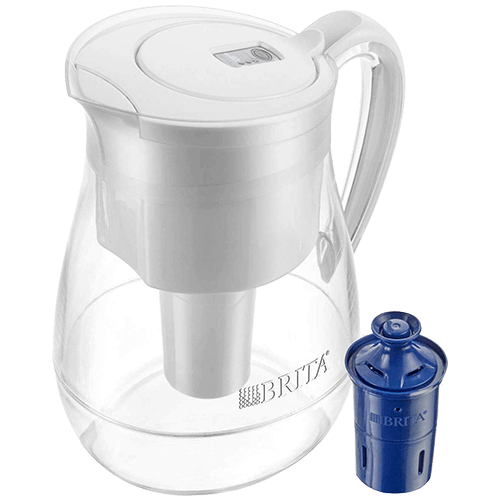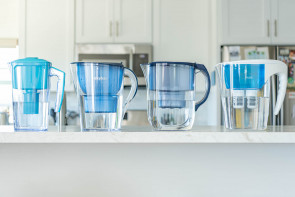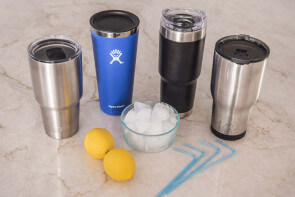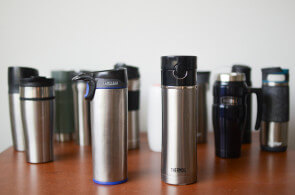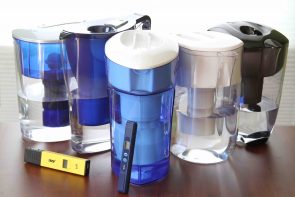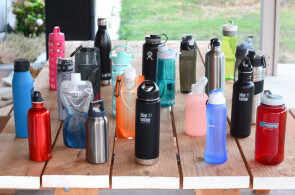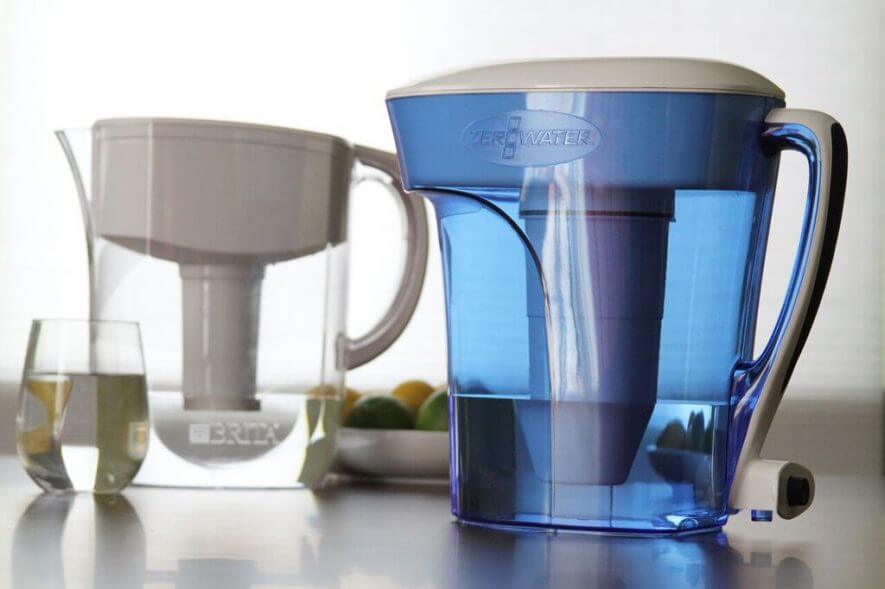
ZeroWater vs. Brita vs. PUR: Who Wins?
There’s good news for water drinkers: Brita, PUR and ZeroWater filters all make tap water safer to drink. Lead filtration is available from all three of these top brands, with certificates from independent agencies. However, we wanted to know how much the resulting water differs, and how much you’re paying for extra filtration.
Featured Product
There’s good news for water drinkers: Brita, PUR and ZeroWater filters all make tap water safer to drink. Lead filtration is available from all three of these top brands, with certificates from independent agencies. However, we wanted to know how much the resulting water differs, and how much you’re paying for extra filtration.
So, after 40 hours of research and initial testing we spent another three years using Brita, ZeroWater and PUR pitchers side-by-side. After our third set of blind taste tests, we found that only the ZeroWater – 6-Cup Pitcher offers the elusive taste profile of purified water, while the Brita – Monterey offers the best value.
This review will focus on the differences between the Brita, PUR and ZeroWater filter pitcher systems. But check out our full review of the best water filters if you’re curious about other competition. Also see our faucet water filter review if you’re interested in the convenience of on-demand filtered water without the hassle of installing a new tap.
In order to compare the Brita, PUR and ZeroWater filter pitchers, we noted differences in certifications, mineral levels, filtration speed and, of course, our office and home taste tests. We also used our general impressions of the products during everyday use over the course of three years of in-home testing.
Table of contents
- Water filter quality
- Ergonomics of each pitcher
- Water filter speed
- Water filter taste tests
- Chlorine removal
- Filter life
- Which water filter is best?
Water filter quality
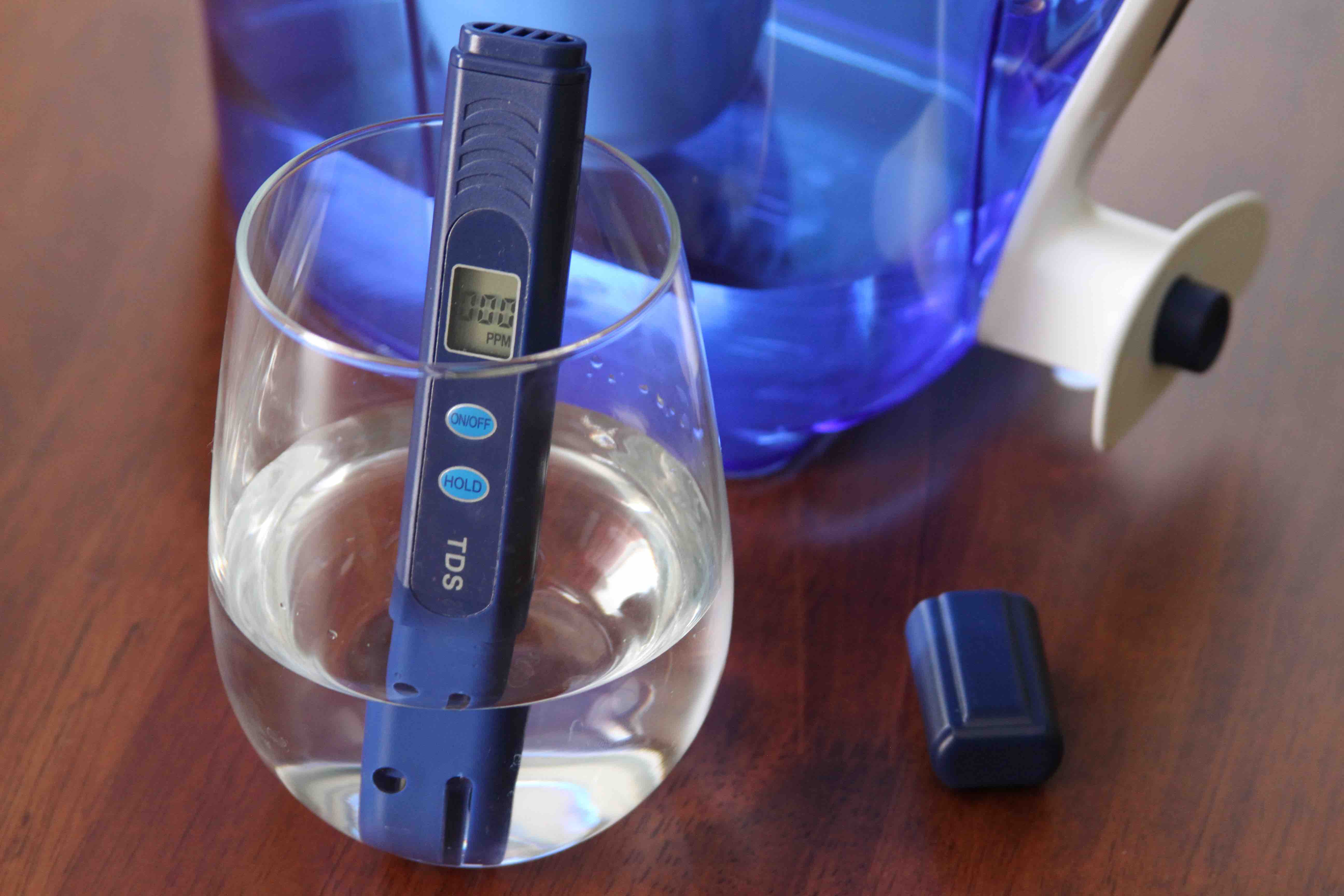
When buying a water filter pitcher, the first and most important metric is how effective the filter actually is at removing harmful substances. All these brands have received certifications from NSF International or the Water Quality Association, specifically focusing on removal of specific harmful materials from municipal tap water.
Brita and PUR have similar filters, especially when it comes to taste. The basic filters from these brands are mostly activated carbon, which grabs organic particles and removes chlorine easily. Both brands now offer an upgraded filter that goes an extra step of removing lead, pharmaceuticals and other contaminants better than the basic filters.
The ZeroWater filter is significantly different than other systems on the market: There’s double the amount of contaminant-grabbing media inside the filter cartridge, and most of it is an ion-exchange resin that removes minerals, metals and salts, not just organic compounds. This is similar to the kind of treatment you’d see in a laboratory or for pharmaceutical manufacturing, and the water is completely pure.
ZeroWater emphasizes this point by including a standard conductivity tester with their pitchers — mineral-free water doesn’t conduct much electricity, so it’s easy to test mineral content that way.
There are some ion-exchange beads in a Brita and PUR filter, too, but not nearly on the same scale. Each filter passes a test for removing lead and at least one other heavy metal, but these filters don’t do much for hard-water minerals like calcium and magnesium.
That means ZeroWater can make a bigger difference for taste, and also that you won’t get hard-water scale in your electric kettle or coffee maker.
Ergonomics of each pitcher
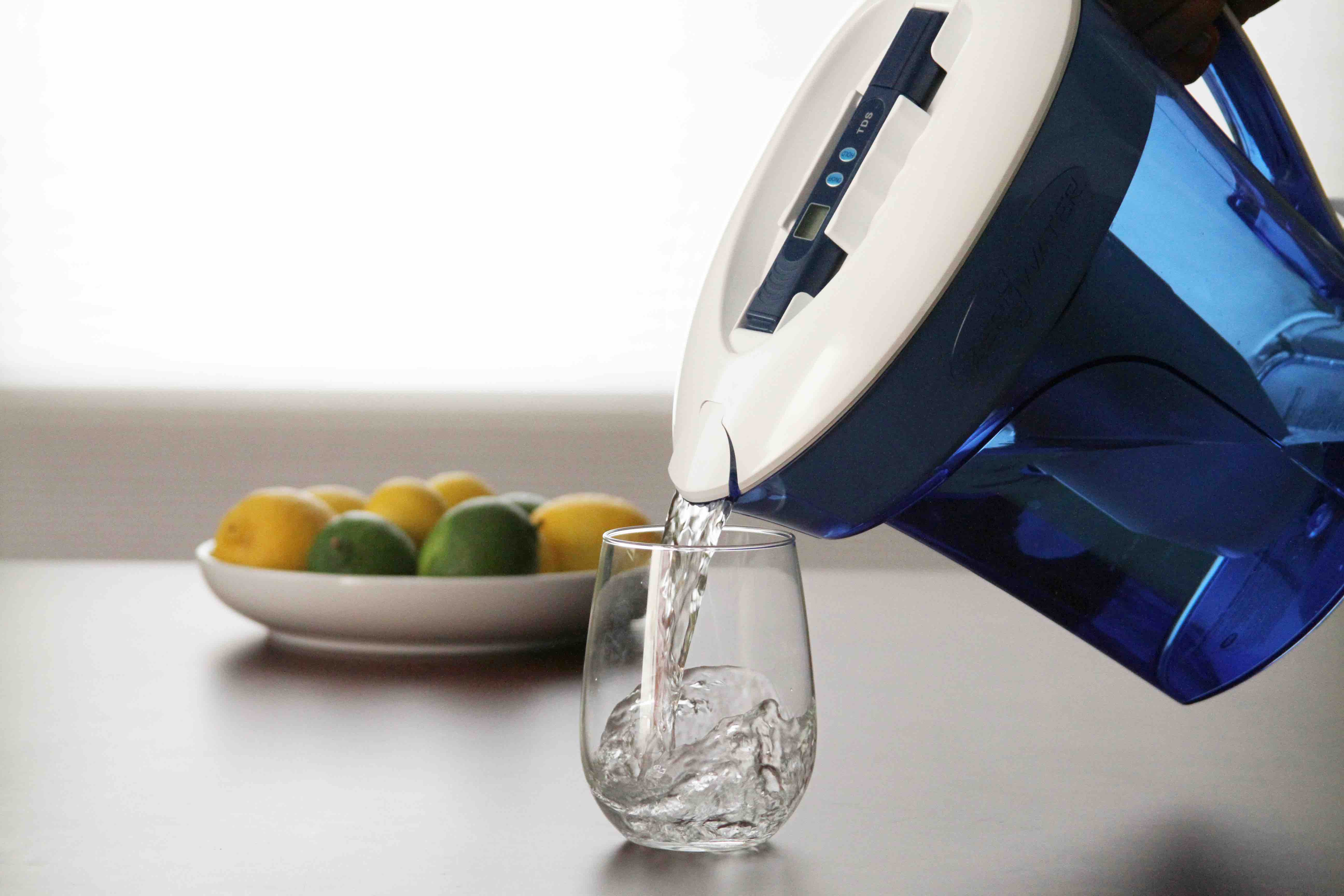
The ergonomics of a water filter pitcher are important as well. A water pitcher should be easy to hold and easy to pour. In addition, the pre-filtered water reservoir should be large enough to fill at least half of the pitcher.
All the pitchers were able to fill at least half of the pitcher itself from one fill of the reservoir, so we looked at the remaining ergonomic factors to differentiate between them.
The PUR filter system has the distinction of an easy-to-use positive locking system for the filter: You have to twist the refill into place, so there’s no chance you’ll accidentally be drinking unfiltered water because you didn’t put it in correctly.
That said, we haven’t had any issues with faulty seals on the Brita; you’ll know if it isn’t installed properly because water will flow through very quickly. ZeroWater’s giant filters also screw onto the reservoir securely.
We found the larger Brita pitcher the most awkward to hold and pour. The weight doesn’t feel particularly balanced, particularly in conjunction with the handle itself. Overall, the Brita pitcher feels like a simple, utilitarian product without much emphasis placed on aesthetic or ergonomic elements.
While we don’t expect the ZeroWater pitcher to be winning any awards for artistic inspiration, we did find the ZeroWater pitcher a more ergonomic experience overall. The first ZeroWater pitcher we tried was the ZeroWater – 10-Cup Pitcher. This design has a spout on the bottom of the pitcher, which is a great idea for those who don’t want to lift a heavy pitcher all the time, but the flow rate is so slow that one test family said they totally ignored it after a week.
If you’re after a pitcher that’s more convenient, we like that the ZeroWater – 6-Cup Pitcher fits more easily in a refrigerator and isn’t so heavy when full. You’ll definitely want to refill it every time you use it, though.
Water filter speed
We also tested each filter to determine how long it would take, on average, to filter one cup of water. While you might not be worried about this result, it’s worth considering how long it takes to get more filtered water if you’re ever going to fill bottles before a trip or serve water at a party.
For this test, the standard Brita filter is a winner at just 40 seconds on average to filter one cup of water. The slowest water filter in our tests used to be the ZeroWater filter, which took an average of 110 seconds to filter one cup of exceptionally-clean water.
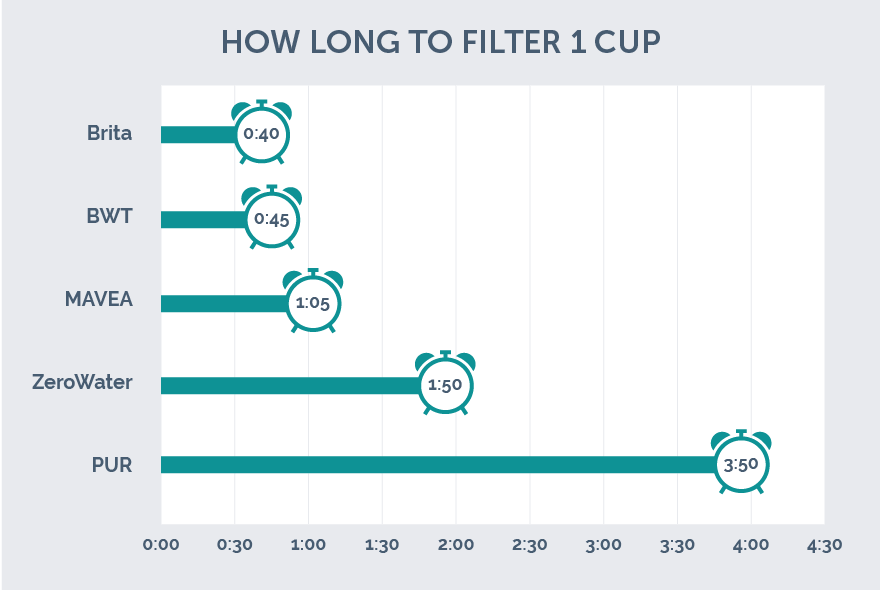
When we switched to the lead-reducing versions of Brita Longlast and PUR filter, though, it was clear that their improved performance over standard carbon filters is related to the speed that water is allowed to trickle through. They take about five times longer than the non-lead-filtering Brita and even longer than the ZeroWater.
With the fluoride-capturing Clearly Filtered pitcher, longer filter times are important to performance as well. But in this case it’s almost unbelievably slow — over 12 minutes to filter one cup with a barely used filter.
Water filter taste tests
One of the first tests we conducted was a blind taste test, but over the years we’ve been surprised at how extreme the individual opinions on this ranking can be. In three different blind tests with groups of office workers, friends and family members, we asked testers to rank unmarked samples for qualities like “dirty,” “refreshing,” “artificial” and “crisp.”
After running two different groups, the results were still tricky to draw conclusions from. But when we ran a third test with controls for what our judges drank at home, preferences lined up into categories: Brita and PUR were more popular with people who drink tap water or spring water, and the mineral-free taste of ZeroWater is a clear winner with those who are used to a reverse-osmosis systems.
Results have shifted over the years for the top rank within the carbon filter group, but the important choice is definitely between leaving minerals in or taking them out.
Comparing these filter categories to bottled water brands, Evian and Arrowhead match the modest mineral levels of our tap water at 300–400 parts per million (ppm). (Perrier and Gerolsteiner are two or three times higher.) There are also bottled products that go through reverse-osmosis treatment to get near-zero levels of dissolved solids, like Dasani and Aquafina. Most bottled water sits somewhere in the middle, at between 50 and 150 ppm.
Chlorine removal
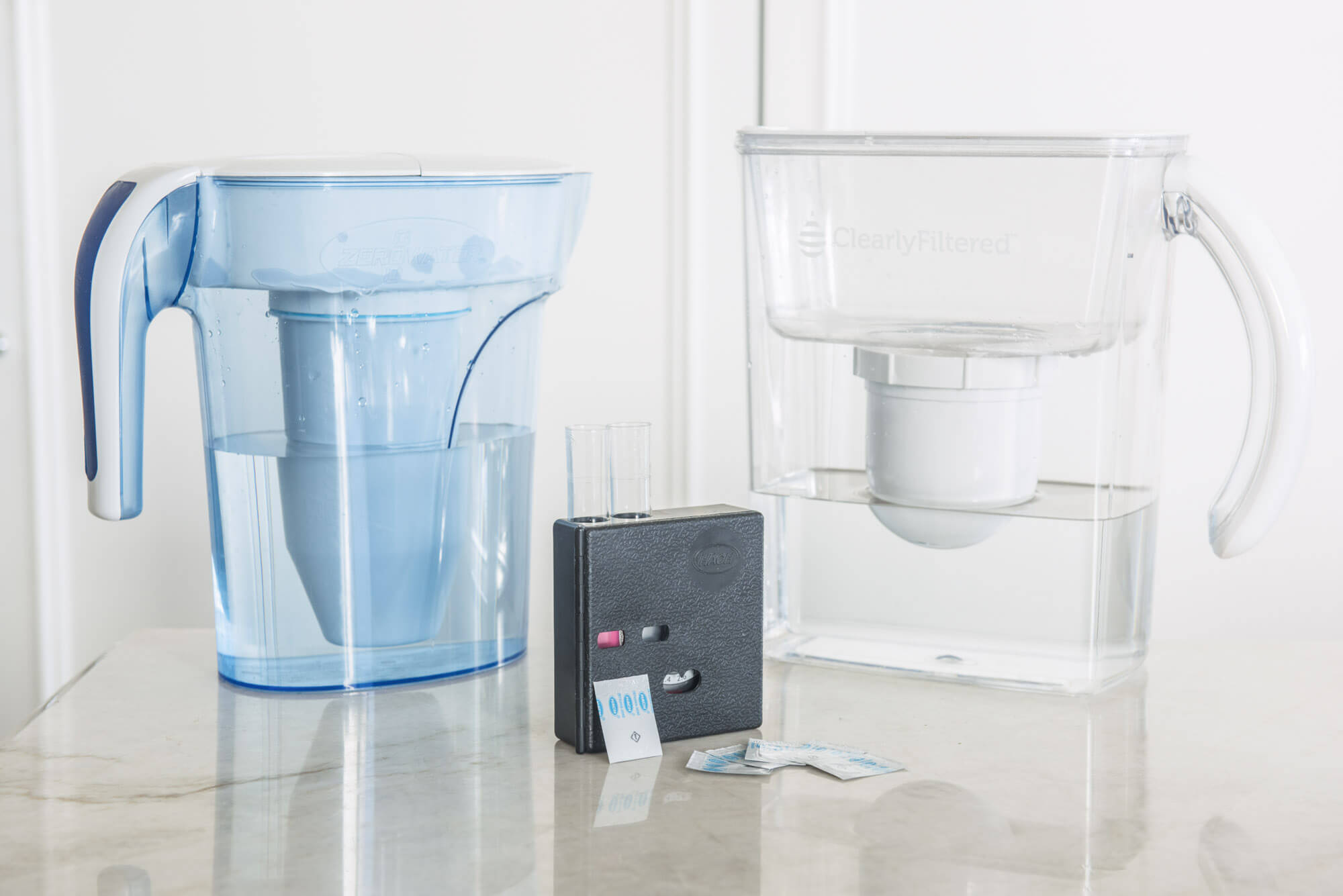
We wanted to see how much difference filter type really makes with taste’s biggest enemy, chlorine. So, we called in a Hatch chlorine test kit that can detect a .01 part-per-million difference in total chlorine.
The tap water we tested had between 0.7 and 1 ppm of chlorine across our tests over one year. We found that any filter we tried in our pitchers, no matter how long it had been in use, would remove all detectable traces of chlorine. The biggest changes in water taste are the easiest to make, so a budget-class Brita filter replacement from the hardware store isn’t actually a bad buy if that’s all you need. But if you’re worried about lead or other contaminants, or if you want a mineral-free taste profile, you’ll need one of these more expensive options.
Filter life
This is the trickiest factor to rate. These filters all rely on capturing particles or attracting ions to an activated medium, which means they have a limited life. Unlike a ceramic or mesh filter that simply clogs up and doesn’t pass water anymore when it’s dirty, these activated filters will just become less effective over time as the contaminants build up and the water just flows past. If you let them go long enough, bacteria or mold can even start growing inside neglected filters.
Brita rates their standard filter for 40 gallons, and the new Longlast Filter at 120 gallons. That’s compared to an average of 15 gallons for a ZeroWater filter before it becomes ineffective.
Those “average” numbers are assuming a lot, though. If you’ve got more than 400 ppm of dissolved solids in your water, ZeroWater cartridges might need replacement after just 10 gallons. There’s a rebate program for recycling, but even at 50% of the typical price of ten dollars per filter, a water softener and reverse-osmosis system start looking more reasonable if you’re filtering more than a gallon per day of something like mineral-rich well water.
In contrast, the Brita filter is doing comparatively little to filter minerals, so it lasts longer. We watched the readings from a new Longlast filter for a few weeks, and after about 10 gallons, the 20% improvement it showed over a standard Brita filter disappeared. You might get better-tasting water for 120 gallons, but after a month we wonder how much the filter is still doing.
If you’re going to be diligent about replacing filters, the ZeroWater system is better at letting you know what’s going on. You can check periodically with the included tester and see when the total dissolved solids climbs up from zero to 6 ppm, and replace the filter before it stops working altogether. When the filter media is saturated with metal ions, it actually starts to release some back into the water, and you’ll immediately notice a sour or fishy taste. In comparison, you never really know when a Brita filter has lost its effectiveness.
Which water filter is best?
| Product | Seconds to Filter 1 Cup | Minerals Remaining (Starting 500 PPM): | Filter Cost per Gallon | Removes Lead |
|---|---|---|---|---|
| Brita – Longlast | 188 | 300 | $0.09 | Yes |
| ZeroWater | 110 | 0 | $0.33 | Yes |
| PUR – Lead Reduction | 230 | 450 | $0.18 | Yes |
| Clearly FIltered | 730 | 400 | $0.46 | Yes |
| Brita – Standard | 40 | 350 | $0.10 | No |
| Waterdrop | 49 | 122 | $0.05 | No |
| Epic Pure | 223 | 141 | $0.24 | Yes |
| Aquagear | 85 | 205 | $0.37 | No |
| BWT (Discontinued) | 45 | 425 | $0.15 | No |
Each of these water filter pitchers has compelling arguments in their favor. They’re certified to remove harmful materials such as lead, and they improve the taste of your water.
Brita and ZeroWater also offer a recycling program, which helps prevent unnecessary materials from ending up in a landfill. However, it’s worth noting that ZeroWater offers a credit of $5 per filter shipped back to them toward new filters, whereas Brita only offers free shipping. (PUR had formerly partnered with Terracycle, but they closed the program in 2019.)
With everything considered, the ZeroWater – 6-Cup Pitcher is a filter that does far more than most of us need. This system utilizes top-tier filtration technology, but it’s not a good value unless you’re specifically chasing the zero-dissolved-solids flavor. The hassle of replacing filters every two or three weeks can be annoying, too.
The PUR system is stuck in an awkward middle ground. It used to be a more thorough system than Brita, but the 40-gallon filter life isn’t competitive anymore now that Brita has lead-removing Longlast filters.
The old Brita system uses less expensive — and less effective — water filters. If you’re looking for a simple, inexpensive way to filter out chlorine, the standard Brita filter is still worth considering.
The happy medium is the new Brita – Longlast Filter. It’s certified to remove lead, along with some pesticides and pharmaceutical compounds, and lasts for six months — three times longer than the PUR or standard Brita filter. That makes it the best value and the most convenient to use, with filter replacements every six months.
More Reviews
The 11 Best Expandable Garden Hoses
Joey's Garden Expandable Hose
The Best Alkaline Water Filter Pitchers
Brita - Longlast
The Best Filtered Water Bottles
Brita - BB10
Brita - FF-100
RTIC - 30-Ounce Tumbler
Brita - Monterey with Longlast Filter
Thermos - Sipp
The 7 Best Water Filter Pitchers
Brita - 10-Cup Everyday Pitcher
Klean Kanteen - 20-Ounce Insulated
Mauviel M'heritage
The 9 Best Infrared Thermometers
ennoLogic - eT650D


